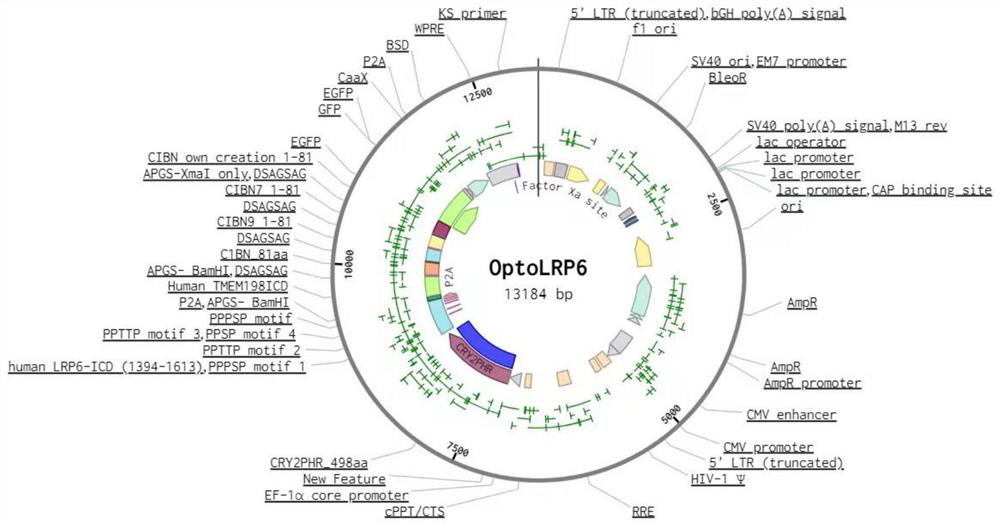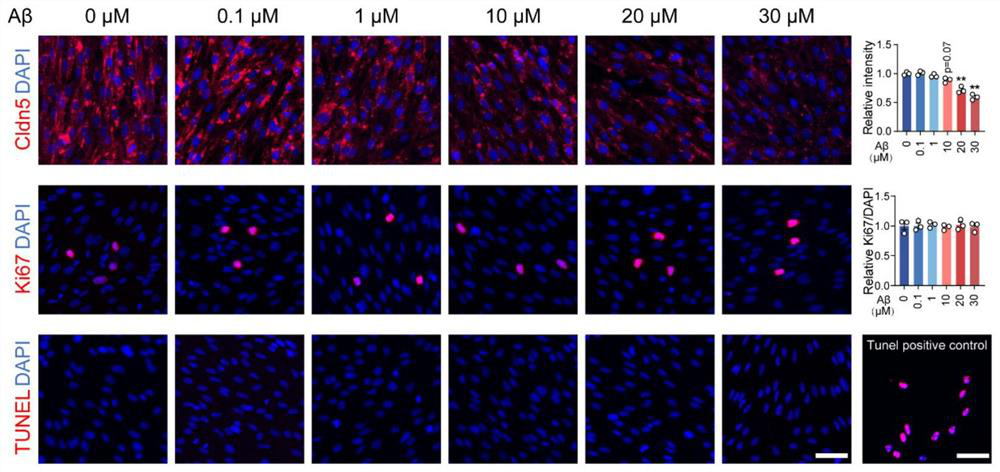Application of tool for targeted activation of LRP6 in preparation of medicine for preventing and treating Alzheimer's disease
An Alzheimer's disease and tool technology, applied in the field of biomedicine, can solve problems such as the lack of prevention and treatment of Alzheimer's disease, relieve the damage of brain endothelial cell function, repair blood-brain barrier damage, application value and good prospects
- Summary
- Abstract
- Description
- Claims
- Application Information
AI Technical Summary
Problems solved by technology
Method used
Image
Examples
Embodiment 1
[0031] Example 1 Preparation of optogenetic tool OptoLRP6
[0032] Preparation steps:
[0033] S1. Construct a light-sensitive control plasmid expressing LRP6 protein, namely OptoLRP6 plasmid (provided by Addgene, whose structure is as follows: figure 1 As shown, the used backbone plasmid is pCS2+);
[0034] S2. Using the third-generation lentivirus preparation system, the plasmid in step S1 was transfected into the HEK293T cell line, and the medium for culturing the HEK293T cell line was replaced every 8 hours after transfection;
[0035] S3. Collect the culture medium of HEK293T cell line 48 hours after transfection in step S2, and filter with a 0.22 μm filter, the obtained filtrate is the plasmid of OptoLRP6.
Embodiment 2
[0036] Example 2 In vitro brain endothelial cell blood-brain barrier injury model
[0037] 1. The purpose of the experiment:
[0038] Preparation of an in vitro model of brain endothelial cell blood-brain barrier injury to test optogenetic tools
[0039] 2. Experimental method:
[0040]Take 10-day-old rat suckling mice, remove the brain tissue after anesthesia, and remove the cerebellum, cerebellum, brain stem and white matter on ice to obtain the remaining cortex; the remaining cortex is homogenized in 10 mL and 1 mL of DMEM, DMEM containing 1 mg / mL of collagenase and 0.1 mg / mL DNase I, and shaken at 250 rpm for 1 h at 37 °C, then centrifuged at 1000 g for 8 min at room temperature; the pellet obtained by centrifugation was suspended in 25 mL of DMEM containing 20% BSA, at room temperature The microvessel pellet was obtained by centrifugation at 1000g for 20 minutes. The microvessel pellet was further homogenized in 5 mL of DMEM containing 0.5 mL of 1 mg / mL collagenase-...
Embodiment 3
[0043] Example 3 Optogenetic tool LRP6 in the treatment of blood-brain barrier damage in vitro caused by Aβ oligomer treatment
[0044] 1. The purpose of the experiment:
[0045] Validation of the therapeutic effect of the optogenetic tool OptoLRP6 on blood-brain barrier damage induced by Aβ oligomer treatment in vitro.
[0046] 2. Experimental method:
[0047] The primary BECs were extracted according to the primary BEC extraction method in Example 2, and the BEC cells were treated with 20 μM Aβ using the blood-brain barrier damage model construction method in Example 2 to establish an in vitro blood-brain barrier damage model. Blue light treatment, specifically blue light (wavelength 450nm) cyclic treatment, that is, turn on the blue light for 20 minutes, and then turn off the blue light for 40 minutes for a total of 8 hours. After the end, collect cell samples to extract RNA and protein samples for relevant indicators and blood-brain barrier function. Detection of protein...
PUM
 Login to View More
Login to View More Abstract
Description
Claims
Application Information
 Login to View More
Login to View More - R&D
- Intellectual Property
- Life Sciences
- Materials
- Tech Scout
- Unparalleled Data Quality
- Higher Quality Content
- 60% Fewer Hallucinations
Browse by: Latest US Patents, China's latest patents, Technical Efficacy Thesaurus, Application Domain, Technology Topic, Popular Technical Reports.
© 2025 PatSnap. All rights reserved.Legal|Privacy policy|Modern Slavery Act Transparency Statement|Sitemap|About US| Contact US: help@patsnap.com



